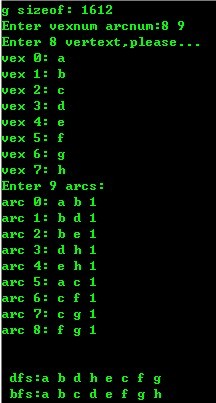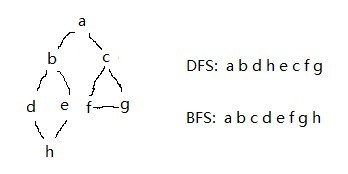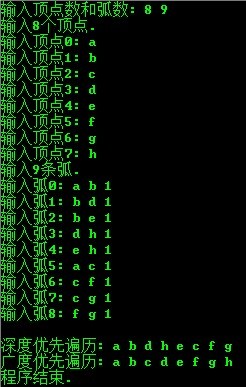图——深度优先和广度优先算法
无向图用二维邻接矩阵表示
测试环境:VC 6.0 (C)
- #include <stdio.h>
- #include <malloc.h>
- #include <stdlib.h>
- #define INFINITY 32767
- #define MAX_VEX 20
- #define QUEUE_SIZE (MAX_VERTEX+1)
- #define DataType char /* vertext's info */
- int *visited; /* Node: visited flag with dynamic array, good idea ! */
- /* init queue for bfs */
- struct _node
- {
- int v_num;
- struct _node *next;
- };
- typedef struct _node node, *pnode;
- struct _queue
- {
- pnode front;
- pnode rear;
- };
- typedef struct _queue queue, *pqueue;
- struct _graph
- {
- DataType *vexs;
- int arcs[MAX_VEX][MAX_VEX];
- int vexnum, arcnum;
- };
- typedef struct _graph graph, *pgraph;
- /* operation of queue */
- queue init_queue()
- {
- queue qu;
- qu.front=qu.rear=(pnode)malloc(sizeof(node));
- if(qu.front == NULL)
- exit(1);
- qu.rear->next=NULL;
- return qu;
- }
- void en_queue(pqueue pqu, int v_num)
- {
- pnode pn;
- pn=(pnode)malloc(sizeof(node));
- if(pqu->front == NULL)
- exit(1);
- pn->v_num=v_num;
- pn->next=NULL;
- pqu->rear->next=pn;
- pqu->rear=pqu->rear->next;
- }
- int isempty_queue(pqueue pqu)
- {
- if(pqu->front == pqu->rear)
- return 1;
- else
- return 0;
- }
- int de_queue(pqueue pqu)
- {
- pnode pn;
- int d;
- if(isempty_queue(pqu))
- return -1;
- pn=pqu->front;
- d=pn->v_num;
- pqu->front=pn->next;
- free(pn);
- return d;
- }
- int locate(graph g, DataType data)
- {
- int i;
- for(i=0;i<g.vexnum;i++)
- if(g.vexs[i] == data)
- return i;
- return -1;
- }
- graph create_graph()
- {
- int i,j,w, s1,s2;
- DataType ch1,ch2,tmp;
- graph g;
- printf("g sizeof: %d/n", sizeof(g));
- printf("Enter vexnum arcnum:");
- scanf("%d %d", &g.vexnum, &g.arcnum);
- tmp=getchar();
- g.vexs=(DataType *)malloc(sizeof(DataType));
- if(g.vexs == NULL)
- exit(1);
- printf("Enter %d vertext,please.../n", g.vexnum);
- for(i=0;i<g.vexnum;i++)
- {
- printf("vex %d: ", i);
- scanf("%c", &g.vexs[i]);
- tmp=getchar();
- //visited[i]=0;
- }
- for(i=0;i<g.vexnum;i++)
- for(j=0;j<g.vexnum;j++)
- g.arcs[i][j]=INFINITY;
- printf("Enter %d arcs:/n", g.arcnum);
- for(i=0;i<g.arcnum;i++)
- {
- printf("arc %d: ", i);
- scanf("%c %c %d", &ch1, &ch2, &w);
- tmp=getchar();
- s1=locate(g, ch1);
- s2=locate(g, ch2);
- g.arcs[s1][s2]=g.arcs[s2][s1]=w; /* NOTE: weight */
- }
- return g;
- }
- int firstvex_graph(graph g, int k)
- {
- int i;
- if(k>=0 && k<g.vexnum)
- for(i=0;i<g.vexnum;i++)
- if(g.arcs[k][i] != INFINITY)
- return i;
- return -1;
- }
- int nextvex_graph(graph g, int i, int j)
- {
- int k;
- if(i>=0 && i<g.vexnum && j>=0 && j<g.vexnum)
- for(k=j+1; k<g.vexnum; k++)
- if(g.arcs[i][k] != INFINITY)
- return k;
- return -1;
- }
- void dfs(graph g, int k)
- {
- int i;
- if(k == -1)
- {
- for(i=0;i<g.vexnum;i++)
- if(!visited[i])
- dfs(g,i);
- }
- else
- {
- visited[k]=1;
- printf("%c ", g.vexs[k]);
- for(i=firstvex_graph(g,k);i>=0;i=nextvex_graph(g,k,i))
- if(!visited[i])
- dfs(g,i);
- }
- }
- void bfs(graph g)
- {
- int i,j,k;
- queue qu;
- qu=init_queue();
- for(i=0;i<g.vexnum;i++)
- if(!visited[i])
- {
- visited[i] =1;
- printf("%c ", g.vexs[i]);
- en_queue(&qu, i);
- while(!isempty_queue(&qu))
- {
- k=de_queue(&qu);
- for(j=firstvex_graph(g,k); j>=0;j=nextvex_graph(g,k,j))
- if(!visited[j])
- {
- visited[j]=1;
- printf("%c ", g.vexs[j]);
- en_queue(&qu, j);
- }
- }
- }
- }
- void main()
- {
- int i;
- graph g;
- g=create_graph();
- visited=(int *)malloc(g.vexnum*sizeof(int));
- for(i=0;i<g.vexnum;i++)
- visited[i]=0;
- printf("/n/n dfs:");
- dfs(g,-1);
- for(i=0;i<g.vexnum;i++)
- visited[i]=0;
- printf("/n bfs:");
- bfs(g);
- if(visited)
- free(visited);
- printf("/n");
- }
运行结果:


======================================================
图 ——深度优先
测试环境:VS2008 (C)
- #include "stdafx.h"
- #include <stdlib.h>
- #include <malloc.h>
- #define MAX_VEX 20
- #define INFINITY 65535
- int *visited;
- struct _node
- {
- int vex_num;
- struct _node *next;
- };
- typedef struct _node node, *pnode;
- struct _graph
- {
- char *vexs;
- int arcs[MAX_VEX][MAX_VEX];
- int vexnum, arcnum;
- };
- typedef struct _graph graph, *pgraph;
- int locate(graph g, char ch)
- {
- int i;
- for(i=1; i<=g.vexnum; i++)
- if(g.vexs[i]==ch)
- return i;
- return -1;
- }
- graph create_graph()
- {
- int i, j, w, p1, p2;
- char ch1, ch2;
- graph g;
- printf("Enter vexnum arcnum: ");
- scanf("%d %d", &g.vexnum, &g.arcnum);
- getchar();
- for(i=1; i<=g.vexnum; i++)
- for(j=1; j<g.vexnum; j++)
- g.arcs[i][j]=INFINITY;
- g.vexs=(char *)malloc(sizeof(char));
- printf("Enter %d vexnum.../n", g.vexnum);
- for(i=1; i<=g.vexnum; i++)
- {
- printf("vex %d: ", i);
- scanf("%c", &g.vexs[i]);
- getchar();
- }
- printf("Enter %d arcnum.../n", g.arcnum);
- for(i=1; i<=g.arcnum; i++)
- {
- printf("arc %d: ", i);
- scanf("%c %c %d", &ch1, &ch2, &w);
- getchar();
- p1=locate(g, ch1);
- p2=locate(g, ch2);
- g.arcs[p1][p2]=g.arcs[p2][p1]=w;
- }
- return g;
- }
- int firstvex_graph(graph g, int i)
- {
- int k;
- if(i>=1 && i<=g.vexnum)
- for(k=1; k<=g.vexnum; k++)
- if(g.arcs[i][k]!=INFINITY)
- return k;
- return -1;
- }
- int nextvex_graph(graph g, int i, int j)
- {
- int k;
- if(i>=1 && i<=g.vexnum && j>=1 && j<=g.vexnum)
- for(k=j+1; k<=g.vexnum; k++)
- if(g.arcs[i][k]!=INFINITY)
- return k;
- return -1;
- }
- void dfs(graph g, int i)
- {
- int k, j;
- if(!visited[i])
- {
- visited[i]=1;
- printf("%c", g.vexs[i]);
- for(j=firstvex_graph(g, i); j>=1; j=nextvex_graph(g, i, j))
- if(!visited[j])
- dfs(g, j);
- }
- }
- void dfs_graph(graph g)
- {
- int i;
- visited=(int *)malloc((g.vexnum+1)*sizeof(int));
- for(i=1; i<=g.vexnum; i++)
- visited[i]=0;
- for(i=1; i<g.vexnum; i++)
- if(!visited[i])
- dfs(g, i);
- }
- int _tmain(int argc, _TCHAR* argv[])
- {
- graph g;
- g=create_graph();
- dfs_graph(g);
- printf("/n");
- return 0;
- }
======================================================
图 ——广度优先
测试环境:VS2008 (C)
- #include "stdafx.h"
- #include <stdlib.h>
- #include <malloc.h>
- #define MAX_VEX 20
- #define INFINITY 65535
- int *visited;
- struct _node
- {
- int data;
- struct _node *next;
- };
- typedef struct _node node, *pnode;
- struct _queue
- {
- pnode front;
- pnode rear;
- };
- typedef struct _queue queue, *pqueue;
- queue init_queue()
- {
- pnode pn=NULL;
- queue qu;
- pn=(pnode)malloc(sizeof(node));
- if(pn==NULL)
- printf("init queue, malloc is fail.../n");
- pn->data=-1;
- pn->next=NULL;
- qu.front=qu.rear=pn;
- return qu;
- }
- int empty_queue(queue qu)
- {
- if(qu.rear==qu.front)
- return 0;
- else
- return 1;
- }
- void en_queue(pqueue pqu, int data)
- {
- pnode pn=NULL;
- if(pqu->rear==NULL)
- return;
- pn=(pnode)malloc(sizeof(node));
- pn->data=data;
- pn->next=pqu->rear->next;
- pqu->rear->next=pn;
- pqu->rear=pn;
- }
- int de_queue(pqueue pqu)
- {
- int data;
- pnode pn=NULL;
- if(pqu->front->next==NULL)
- return -1;
- pn=pqu->front->next;
- pqu->front=pqu->front->next;
- data=pn->data;
- free(pn);
- return data;
- }
- struct _graph
- {
- char *vexs;
- int arcs[MAX_VEX][MAX_VEX];
- int vexnum, arcnum;
- };
- typedef _graph graph, *pgraph;
- int locate(graph g, char ch)
- {
- int i;
- for(i=1; i<=g.vexnum; i++)
- if(g.vexs[i]==ch)
- return i;
- return -1;
- }
- graph create_graph()
- {
- int i, j, w, p1, p2;
- char ch1, ch2;
- graph g;
- printf("Enter vexnum arcnum: ");
- scanf("%d %d", &g.vexnum, &g.arcnum);
- getchar();
- for(i=1; i<=g.vexnum; i++)
- for(j=1; j<g.vexnum; j++)
- g.arcs[i][j]=INFINITY;
- g.vexs=(char *)malloc((g.vexnum+1)*sizeof(char));
- printf("Enter %d vexnum.../n", g.vexnum);
- for(i=1; i<=g.vexnum; i++)
- {
- printf("vex %d: ", i);
- scanf("%c", &g.vexs[i]);
- getchar();
- }
- printf("Enter %d arcnum.../n", g.arcnum);
- for(i=1; i<=g.arcnum; i++)
- {
- printf("arc %d: ", i);
- scanf("%c %c %d", &ch1, &ch2, &w);
- getchar();
- p1=locate(g, ch1);
- p2=locate(g, ch2);
- g.arcs[p1][p2]=g.arcs[p2][p1]=w;
- }
- return g;
- }
- int firstvex_graph(graph g, int i)
- {
- int k;
- if(i>=1 && i<=g.vexnum)
- for(k=1; k<=g.vexnum; k++)
- if(g.arcs[i][k]!=INFINITY)
- return k;
- return -1;
- }
- int nextvex_graph(graph g, int i, int j)
- {
- int k;
- if(i>=1 && i<=g.vexnum && j>=1 && j<=g.vexnum)
- for(k=j+1; k<=g.vexnum; k++)
- if(g.arcs[i][k]!=INFINITY)
- return k;
- return -1;
- }
- void bfs(graph g)
- {
- int i, ivex, inextvex;
- visited=(int *)malloc((g.vexnum+1)*sizeof(int));
- for(i=1; i<=g.vexnum; i++)
- visited[i]=0;
- queue qu=init_queue();
- for(i=1; i<=g.vexnum; i++)
- {
- if(!visited[i])
- {
- visited[i]=1;
- printf("%c", g.vexs[i]);
- en_queue(&qu, i);
- }
- while(!empty_queue(qu))
- {
- ivex=de_queue(&qu);
- for(inextvex=firstvex_graph(g, ivex); inextvex>=1; inextvex=nextvex_graph(g, ivex, inextvex))
- if(!visited[inextvex])
- {
- visited[inextvex]=1;
- printf("%c", g.vexs[inextvex]);
- en_queue(&qu, inextvex);
- }
- }
- }
- }
- int _tmain(int argc, _TCHAR* argv[])
- {
- graph g;
- g=create_graph();
- bfs(g);
- printf("/n");
- return 0;
- }
======================================================
图 ——深度优先和广度优先算法2(网摘)
本文引用网址:http://bbs.bccn.net/thread-155311-1-1.html(编程论坛)
看到本算法在网上转载较多,比较流行,且能直接运行
但发现大多转载中,也把DFS与BFS正好写反了,对此本文已修正
此外,本算法混用了C与C++,不够单纯,申请的指针空间也未及时释放
测试环境:VC 6.0 (C)
- #include <stdio.h>
- #include <malloc.h>
- #define INFINITY 32767
- #define MAX_VEX 20
- #define QUEUE_SIZE (MAX_VEX+1)
- bool *visited;
- typedef struct
- {
- char *vexs; //顶点向量
- int arcs[MAX_VEX][MAX_VEX]; //邻接矩阵
- int vexnum,arcnum; //图的当前顶点数和弧数
- }Graph;
- //队列类
- class Queue
- {
- public:
- void InitQueue(){
- base=(int *)malloc(QUEUE_SIZE*sizeof(int));
- front=rear=0;
- }
- void EnQueue(int e)
- {
- base[rear]=e;
- rear=(rear+1)%QUEUE_SIZE;
- }
- void DeQueue(int &e)
- {
- e=base[front];
- front=(front+1)%QUEUE_SIZE;
- }
- public:
- int *base;
- int front;
- int rear;
- };
- //图G中查找元素c的位置
- int Locate(Graph G,char c)
- {
- for(int i=0;i<G.vexnum;i++)
- if(G.vexs[i]==c)
- return i;
- return -1;
- }
- //创建无向网
- void CreateUDN(Graph &G){
- int i,j,w,s1,s2;
- char a,b,temp;
- printf("输入顶点数和弧数: ");
- scanf("%d%d",&G.vexnum,&G.arcnum);
- temp=getchar(); //接收回车
- G.vexs=(char *)malloc(G.vexnum*sizeof(char)); //分配顶点数目
- printf("输入%d个顶点./n",G.vexnum);
- for(i=0;i<G.vexnum;i++) //初始化顶点
- {
- printf("输入顶点%d: ",i);
- scanf("%c",&G.vexs[i]);
- temp=getchar(); //接收回车
- }
- for(i=0;i<G.vexnum;i++) //初始化邻接矩阵
- for(j=0;j<G.vexnum;j++)
- G.arcs[i][j]=INFINITY;
- printf("输入%d条弧./n",G.arcnum);
- for(i=0;i<G.arcnum;i++)
- { //初始化弧
- printf("输入弧%d: ",i);
- scanf("%c %c %d",&a,&b,&w); //输入一条边依附的顶点和权值
- temp=getchar(); //接收回车
- s1=Locate(G,a);
- s2=Locate(G,b);
- G.arcs[s1][s2]=G.arcs[s2][s1]=w;
- }
- }
- //图G中顶点k的第一个邻接顶点
- int FirstVex(Graph G,int k)
- {
- if(k>=0 && k<G.vexnum) //k合理
- for(int i=0;i<G.vexnum;i++)
- if(G.arcs[k][i]!=INFINITY) return i;
- return -1;
- }
- //图G中顶点i的第j个邻接顶点的下一个邻接顶点
- int NextVex(Graph G,int i,int j)
- {
- if(i>=0 && i<G.vexnum && j>=0 && j<G.vexnum) //i,j合理
- for(int k=j+1;k<G.vexnum;k++)
- if(G.arcs[i][k]!=INFINITY)
- return k;
- return -1;
- }
- //深度优先遍历
- void DFS(Graph G,int k)
- {
- int i;
- if(k==-1) //第一次执行DFS时,k为-1
- {
- for(i=0;i<G.vexnum;i++)
- if(!visited[i])
- DFS(G,i); //对尚未访问的顶点调用DFS
- }
- else
- {
- visited[k]=true;
- printf("%c ",G.vexs[k]); //访问第k个顶点
- for(i=FirstVex(G,k);i>=0;i=NextVex(G,k,i))
- if(!visited[i]) //对k的尚未访问的邻接顶点i递归调用DFS
- DFS(G,i);
- }
- }
- //广度优先遍历
- void BFS(Graph G)
- {
- int k;
- Queue Q; //辅助队列Q
- Q.InitQueue();
- for(int i=0;i<G.vexnum;i++)
- if(!visited[i]) //i尚未访问
- {
- visited[i]=true;
- printf("%c ",G.vexs[i]);
- Q.EnQueue(i); //i入列
- while(Q.front!=Q.rear)
- {
- Q.DeQueue(k); //队头元素出列并置为k
- for(int w=FirstVex(G,k);w>=0;w=NextVex(G,k,w))
- if(!visited[w]) //w为k的尚未访问的邻接顶点
- {
- visited[w]=true;
- printf("%c ",G.vexs[w]);
- Q.EnQueue(w);
- }
- }
- }
- }
- //主函数
- void main(){
- int i;
- Graph G;
- CreateUDN(G);
- visited=(bool *)malloc(G.vexnum*sizeof(bool));
- printf("/n深度优先遍历: ");
- for(i=0;i<G.vexnum;i++)
- visited[i]=false;
- DFS(G,-1); /* NODE: DFS */
- printf("/n广度优先遍历: ");
- for(i=0;i<G.vexnum;i++)
- visited[i]=false;
- BFS(G); /* NODE: BFS */
- printf("/n程序结束./n");
- }
运行结果:


======================================================
- #include <iostream.h>
- #include <stdlib.h>
- #define INFINITY 0
- #define MAX_VERTEX_NUM 10 //最大顶点数
- #define MAX_EDGE_NUM 40 //最大边数
- typedef enum {DG,DN,UDG,UDN}Graphkind;
- typedef char VertexType; //顶点数据类型
- typedef struct ArcCell
- {
- int adj; //无权图,1或0表示相邻否;带权图则是权值。
- //int *info;
- }ArcCell,AdjMatrix[MAX_VERTEX_NUM][MAX_VERTEX_NUM];
- typedef struct
- {
- VertexType vexs[MAX_VERTEX_NUM]; //顶点向量
- AdjMatrix arcs; //邻接矩阵
- int vexnum,arcnum; //图的当前顶点数和弧数。
- Graphkind kind;
- }MGraph;
- int LocateVex(MGraph G,VertexType v1)
- {
- int i;
- for(i=0;i<G.vexnum;i++)
- if(G.vexs[i]==v1)
- return i;
- return -1;
- }
- int CreatUDN(MGraph &G)
- // 采用数组表示法,构造无向网 G
- {
- VertexType v1,v2;
- int w,j;
- cout<<"输入图的顶点数"<<endl;
- cin>>G.vexnum;
- cout<<"输入图的弧数"<<endl;
- cin>>G.arcnum;
- for(int i=0;i<G.vexnum;i++)
- {
- cout<<"输入顶点向量"<<endl;
- cin>>G.vexs[i];
- }
- for(i=0;i<G.vexnum;i++)
- for(j=0;j<G.vexnum;j++)
- {
- G.arcs[i][j].adj=INFINITY;
- }
- for(int k=0;k<G.arcnum;++k) //构造邻接矩阵
- {
- cout<<"输入边依附的两个顶点"<<endl;
- cin>>v1>>v2;
- cout<<"输入此边的权值"<<endl;
- cin>>w;
- i=LocateVex(G,v1);
- j=LocateVex(G,v2);
- G.arcs[i][j].adj=w;
- G.arcs[j][i].adj=G.arcs[i][j].adj;
- }
- return 1;
- }
- void dispMGraph(MGraph G)
- {
- cout<<"图的邻接矩阵图是:"<<endl;
- for(int i=0;i<G.vexnum;i++)
- {
- for(int j=0;j<G.vexnum;j++)
- cout<<" "<<G.arcs[i][j].adj;
- cout<<endl;
- }
- }
- void main()
- {
- MGraph G;
- CreatUDN(G);
- dispMGraph(G);
- }
- // 邻接表 表示:
- #include <iostream.h>
- #include <stdlib.h>
- #define MAX_VERTEX_NUM 20 //最大顶点数
- #define MAX_EDGE_NUM 40 //最大边数
- int visited[ MAX_VERTEX_NUM];
- typedef int VertexType ; //顶点数据类型
- typedef struct ArcNode
- {
- int adjvex;
- int weight;
- struct ArcNode *nextarc;
- }ArcNode;
- typedef struct VNode
- {
- VertexType data;
- ArcNode *firstarc;
- }VNode,AdjList[MAX_VERTEX_NUM];
- typedef struct
- {
- AdjList vertices;
- int vexnum,arcnum;
- int kind;
- }ALGraph;
- void CreateDG(ALGraph &G)
- {
- int i,j,k;
- ArcNode *p;
- cout<<"创建一个图:"<<endl;
- cout<<"顶点数:"; cin>>G.vexnum;cout<<endl;
- cout<<"边数:"; cin>>G.arcnum; cout<<endl;
- for(i=0;i<G.vexnum;i++)
- {
- G.vertices[i].data=i;
- G.vertices[i].firstarc=NULL;
- }
- for(k=0;k<G.arcnum;k++)
- {
- cout<<"请输入第"<<k+1<<"条边:";
- cin>>i>>j;
- p=(ArcNode*)malloc(sizeof(ArcNode));
- p->adjvex=j;
- p->nextarc=G.vertices[i].firstarc;
- G.vertices[i].firstarc=p;
- }
- }
- void Disp(ALGraph G)
- {
- int i,j;
- ArcNode *p;
- cout<<"输出图为:"<<endl;
- for(i=0;i<G.vexnum;i++)
- {
- p=G.vertices[i].firstarc;
- j=0;
- while(p!=NULL)
- {
- cout<<"("<<i<<","<<p->adjvex<<")";
- p=p->nextarc;
- j=1;
- }
- if(j==1)
- cout<<endl;
- }
- }
- void dfs(ALGraph G,int v) //深度优先遍历
- {
- ArcNode *p;
- cout<<v<<" ";
- visited[v]=1;
- p=G.vertices[v].firstarc;
- while(p!=NULL)
- { if(!visited[p->adjvex])
- dfs(G,p->adjvex);
- p=p->nextarc;
- }
- return ;
- }
- void dfs1(ALGraph G)
- {
- int i;
- for(i=0;i<G.vexnum;i++)
- if(visited[i]==0)
- dfs(G,i);
- }
- void main()
- {
- ALGraph G;
- CreateDG(G);
- int v;
- Disp(G);
- cout<<"输入顶点:";
- cin>>v;
- cout<<"深度优先序列:";
- dfs1(G);
- cout<<endl;
原文链接:http://blog.csdn.net/Sunboy_2050/article/details/5645828